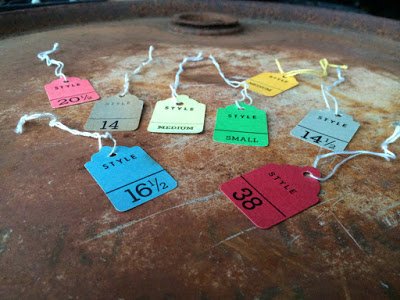The Loch Ness monster has nothing on vintage fashion.
A few years ago I compiled a collection of myths that persist around the subject of wearing vintage fashion.
I think the subject needs frequent revisiting, so here’s an updated version of the original post.

Vintage myth busting
My colleagues at the Vintage Fashion Guild helped me compile myths we often hear.
1. All vintage is small.
Absolutely not true. Although there are more vintage items in the XS, small and medium sizes, there are plenty in larger sizes.
Among other searches, search XL vintage dresses on Etsy. Search plus size vintage dresses on Etsy. Always check the measurements and compare them to your own, as I described in my post Understanding vintage sizes, ease to allow for a good fit. If you are plus size and have questions, you might find an answer (and inspiration) in the honest and positive writing and photos by Va-Voom Vintage.
2. You can find all vintage at a thrift store cheap.
If you can, would you mind sending me the address of said thrift? If you love the thrill of the hunt, feel free to hunt—you may find something you love. In many places, thrift store vintage tends to be ordinary to lower quality 80s and newer. Some may live where there are great finds to be had, but most are not so lucky.
3. Everything that is listed as Mad Men or Downton Abbey dates from the era portrayed in the shows.
Beware of popular keywords used to sell vintage items. I have seen 1980s dresses listed as Mad Men—“flapper dresses” from the 80s as well. Some popular keywords that I’ve seen used, shall we say, cavalierly: Mod, Hippie, Flapper, Gatsby, Titanic. There are more...many more. If you are looking for a vibe, and don’t care when the item comes from, then you may be fine picking out a sequined dress made in India in the 80s and wearing it as a flapper. It may be the best choice among wearable clothes for the purpose. Just be informed so you don’t pay authentic flapper prices!
4. The size tag in a vintage item is the current size.
I worked to cover this in Understanding vintage sizes, ease to allow for a good fit. I’ve seen people put down vintage size 14 items that would fit them perfectly because they are sure they would never wear a 14. Numbers are just numbers, and vintage numbers are particularly disconcerting to the modern mind.
5. A price tag in a vintage item indicates something like the current value.
See my post Getting started with vintage quality and value.
6. Sears items from the 1950s are like Sears items now.
Sears, like many U.S. stores, once stocked clothing made in the U.S. almost exclusively. The quality, style and construction surpassed what you will generally see today. Even though it was considered day-to-day, vintage ordinary quality beats new ordinary quality, hands down.
Velvet hat from vintagestew, yellow eyelet dress from thesweetlifevintage, black leather gloves from countryroadgifts, lavender dress from sodashopvintage polka dot dress from ThisBlueBird, swimsuit from BlueVelvetAustin—all items from the 1950s, 60s and 70s currently available with Sears labels
7. All used clothing is musty, dirty, etc.
Some is, much isn’t. For those just getting started with vintage, it is a better bet to purchase items in excellent condition, and keep a sharp eye (and nose) out for damage. In my experience, most odors can be removed from clothing (some take awhile), except sweat.
8. Vintage clothes look like costumes.
Tell that to Roberta_The_Rimbaud on Chictopia, wearing her vintage dress, gloves, bag, and shoes, and Ashley Ordling in her vintage coat and shoes on her Fancy Fine blog. Chictopia is one place to find lots of people wearing vintage clothing in their own way, as are many style blogs incorporating vintage.
9. You can buy a 1920s flapper dress to wear to a roaring 20s party.
This quite stunning authentic 20s beaded silk dress from Guermantes Vintage is (justifiably) $2,675. Even if in wonderful condition, with the weight of the beading on silk, wearing this gorgeous dress would take the utmost care. I’d say the Charleston is out.
10. The most valuable vintage items from your closet (your mother’s and grandmother’s too) are your wedding dress and your fur coat.
I’m very sorry to say it, but the prices paid for these two categories of items set up the assumption that their value must be quite great now. Wedding dresses are such a personal thing, and although there are beautiful exceptions, often a vintage wedding dress is not classic enough, and has stains or other frailties that make a woman not want it for her big day. I love to see wedding dresses passed down in a family. Furs likewise.
11. Wear what your grandmother wore? It has to be frumpy!
Oh yeah?
12. You’ll find an original Dior New Look or 20s Chanel suit or Westwood punk outfit at your local vintage clothing shop if you ask nicely.
You can bring a box of chocolates, and a million dollars, but the most desirable items will not materialize often.
13. This belonged to my mother’s best friend’s aunt and she had good taste....so it must be valuable.
and 14. I just tossed three huge trash bags filled with my mother’s 50s dresses...they’re worthless aren’t they?
The extremes are often wrong: For the most part vintage (New Look Dior aside) is not worth its weight in gold, but it certainly has value. You can get a feel for its going rate at any given time by searching the internet.
15. If it has a side zipper it is definitely from the 40s. If it has a nylon zipper it is definitely 70s or newer. A crinoline slip in a skirt or dress means it is from the 50s. If it’s beaded it’s flapper. If it has shoulder pads it is from the 40s. If it has pinked seams it has to be vintage.
There are ways to identify the vintages of items, but there are no blanket statements like these that hold true in every case. Look at the Quick Tips for Dating Vintage on the Vintage Fashion Guild site for some basics, but realize that it isn’t a perfect science. For instance, metal zippers were used by home seamstresses long after they went out of use by manufacturers. Reproduction and vintage-inspired clothing can often fool a newcomer to vintage. In this post I make more suggestions for further research.
16. Everything vintage belonged to dead people.
OK, this one makes me laugh, but it is a serious issue for some. If you truly feel squeamish at the thought of wearing something someone else wore, keep in mind that the new clothing you try on may also have been worn by someone else, in the dressing room, or before being returned to the store.
Yes, many a person has passed on whose clothing is perfectly fine. You honor them by keeping this facet of their history alive. Older women have told me they are very pleased to have their clothing be worn by younger people around the world.
17. There is such a thing as vintage condition.
This is a term often used to say something like “good considering it is old.” That kind of muddies the waters, as in reality, vintage items can be good as new, excellent, etc., without further qualification.
[When I first posted this blog, it caused some discussion among people in the vintage fashion marketplace, so I wrote an additional post about condition
to help clarify my position.]
18. This belonged to my mother’s best friend’s mother and she swore it was from the 1920s, so it has to be.
It is amazing how many people remember with scientific clarity exactly when and where they purchased and wore certain items. Then there are those who don’t.
19. If it does not have a label it must be a knockoff or is poorly made.
and 20. All labels are important.
When you get more into vintage, you will find that some of the very best items are without labels. Labels are great to see, and sometimes help you understand the history of the item, but not all are distinguished. On the flip side, some people removed great labels, perhaps as souvenirs. I have had a 1950s Dior suit without label, and only by consulting a number of experts was I able to confirm that the Dior jacquard lining wasn’t lying!
21. If it has a label with a name, that name was a designer.
Often there is a designer name or two behind a label, but the label itself may not give you a clue. One case in point is Suzy Perette...there was no Suzy. See the Vintage Fashion Guild’s Label Resource for the story behind the labels.
1950s Suzy Perette-label dress available from CarlaAndCarla
22. Don’t worry about the stains, you can just dye it.
I you are a dyeing expert, maybe. If you are a dyeing expert, you will know that some fabrics (assuming they are washable) take dye much better than others, and some older fabrics simply can’t stand up to the conditions of a dye bath. I would not suggest purchasing something while making the assumption that such a project will work out.
23. Every bathing suit was pin-up and every secretary was sexy.
Would that it were so. The clothing certainly helped though!
Got any more vintage clothing myths?
📧 Keep track of my vintage fashion ideas and deals by subscribing to the denisebrain newsletter!









